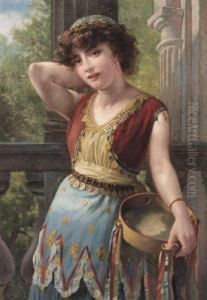Sebastiano Panunzi Paintings
Sebastiano Panunzi was an Italian painter associated with the Macchiaioli group, born in 1836 in Gaeta, Italy, and passing away in 1900. The Macchiaioli were a group of Italian artists active in Tuscany in the second half of the 19th century, who rebelled against the antiquated conventions taught by the Italian art academies. They are often seen as precursors to the Impressionists, focusing on the play of light and shadow, and the use of patches of color - 'macchie' in Italian, hence their name.
Panunzi's early life saw him moving to Florence, which was a hub for artists and intellectuals in Italy during that period. It was here that he became involved with the Macchiaioli movement, developing close ties with other prominent figures such as Giovanni Fattori, Silvestro Lega, and Telemaco Signorini. These connections greatly influenced his artistic development and the evolution of his style. Panunzi's work, like that of his Macchiaioli contemporaries, focused on landscapes, domestic scenes, and military subjects, emphasizing the effects of light and color over strict narrative content.
Despite his association with the Macchiaioli group, Panunzi maintained a distinct personal style characterized by a delicate touch and a refined use of color. His landscapes and scenes of everyday life in the Italian countryside are marked by a serene atmosphere and a subtle, evocative use of light. Throughout his career, Panunzi remained dedicated to capturing the transient effects of light on the natural world, a pursuit that aligned him with the broader aims of the Macchiaioli movement while also distinguishing his work as uniquely sensitive and introspective.
Panunzi's contributions to Italian art were recognized in his time, and he participated in various important exhibitions, including those of the Società Promotrice di Belle Arti in Florence. His works are now part of collections in several Italian museums, testament to his enduring legacy as a key figure within the Macchiaioli movement and Italian art history. Despite the acclaim, Panunzi, like many of his contemporaries, faced challenges in gaining the same level of international recognition as the French Impressionists. Nonetheless, his work remains a significant part of the narrative of 19th-century European art, offering insights into the transitional period leading up to modernism.


